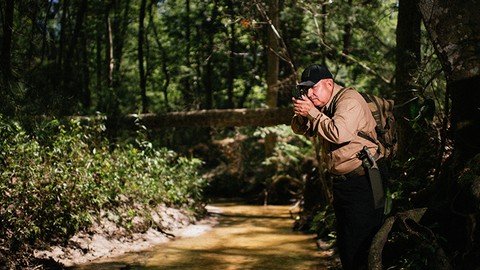
Published 1/2023
MP4 | Video: h264, 1280x720 | Audio: AAC, 44.1 KHz
Language: English | Size: 1.87 GB | Duration: 1h 30m
Tech will fail, either in everyday life or in an emergency. This course will teach you basic Land Navigation
What you'll learn
How to navigate without a GPS
How to make your own compass
How to correctly read a topographic map
Hide and locate a secret cache without losing it
Requirements
No experience necessary!
Description
Tech will fail, either in everyday life or in an emergency. This film will get you up to speed on how to effectively navigate your way to safety with nothing more than a compass and a map. If you need more, this film has it from finding where you are, primitive compass techniques, hiding caches, and more.LEARN: Declination | Compass types | Pace count | How to navigate without a GPS | Azimuth | How to make your own compass | How to correctly read a topographic map | Understand "Declination" and why it's important | Find where you are on a map so you can correctly navigate towards water (or other essential resource) | Hide and locate a secret cache without losing it | Determine what makes a good compass | Route planning and selection #land navigationDeclination: Declination is the angular difference between true north (the direction towards the North Pole) and magnetic north (the direction towards the magnetic north pole). This difference varies depending on location and is important for navigation because a compass points to magnetic north, not true north.Compass Types: There are several types of compasses, including baseplate compasses, lensatic compasses, and military compasses. Baseplate compasses are the most common and are designed for general navigation. Lensatic compasses are used by the military and have a sighting mechanism for more precise navigation. Military compasses are designed for rugged use and often have additional features like a sighting mechanism or a rotating bezel for determining direction.Pace Count: A pace count is a method of measuring distance traveled by counting the number of steps taken. It is used in land navigation to estimate the distance traveled and to help determine the location on a map.Navigating Without a GPS: There are several methods for navigating without a GPS, including using a compass and a map, following landmarks, and using the stars. A compass and a map are the most reliable way to navigate without a GPS. To use a compass and a map, you must know how to orient the map to the terrain, how to read a topographic map, and how to determine your position using the map and compass.Azimuth: Azimuth is the angular measurement of a direction relative to true north. It is measured in degrees and can be used to determine direction when navigating with a compass.Making Your Own Compass: A basic compass can be made by using a magnetized needle (such as a sewing needle) and floating it on a small piece of cork or leaf in a bowl of water. You can also make a compass using a magnetized needle and a piece of paper or a leaf.Reading a Topographic Map: To correctly read a topographic map, you must first orient the map to the terrain by aligning the map's north with true north. Then, you must use the contour lines to identify elevation changes and locate landmarks. You should also be able to read the map legend and understand the symbols used on the map.Declination and its Importance: Declination is important for navigation because a compass points to magnetic north, not true north. The difference between magnetic north and true north, known as declination, varies depending on location. Knowing the declination for your location allows you to adjust your compass readings to ensure that you are navigating towards true north.Locating Water: To find water on a map, you should look for blue areas, which indicate the presence of a river or lake. You can also look for a symbol of a spring or well. Once you have located a water source on the map, you can use your compass and pace count to navigate to it.Hiding and Locating a Secret Cache: To hide a secret cache, you should choose a location that is difficult to access, such as a remote location or a dense forest. You should also choose a location that is unlikely to be disturbed, such as a location that is far from a trail or a road. Once you have hidden the cache, you can use a map and compass to navigate back to it.
Overview
Section 1: Introduction
Lecture 1 Introduction - Part 1
Lecture 2 Introduction - Part 2
Lecture 3 UTM - Part 1
Lecture 4 UTM - Part 2
Lecture 5 Plot and Find Grid
Lecture 6 Field Challenge
Lecture 7 Sand Table
Lecture 8 Gazetteer
Tech will fail, either in everyday life or in an emergency. This film will get you up to speed on how to effectively navigate your way to safety with nothing more than a compass and a map.
Homepage
Code:
https://www.udemy.com/course/survival-land-navigation/Recommend Download Link Hight Speed | Please Say Thanks Keep Topic Live
Fikper
dbice.Survival.Land.Navigation.part2.rar.html
dbice.Survival.Land.Navigation.part1.rar.html
Download Rapidgator
dbice.Survival.Land.Navigation.part2.rar.html
dbice.Survival.Land.Navigation.part1.rar.html
Download Uploadgig
dbice.Survival.Land.Navigation.part2.rar
dbice.Survival.Land.Navigation.part1.rar
Download Nitroflare
dbice.Survival.Land.Navigation.part1.rar
dbice.Survival.Land.Navigation.part2.rar
Links are Interchangeable - No Password - Single Extraction
